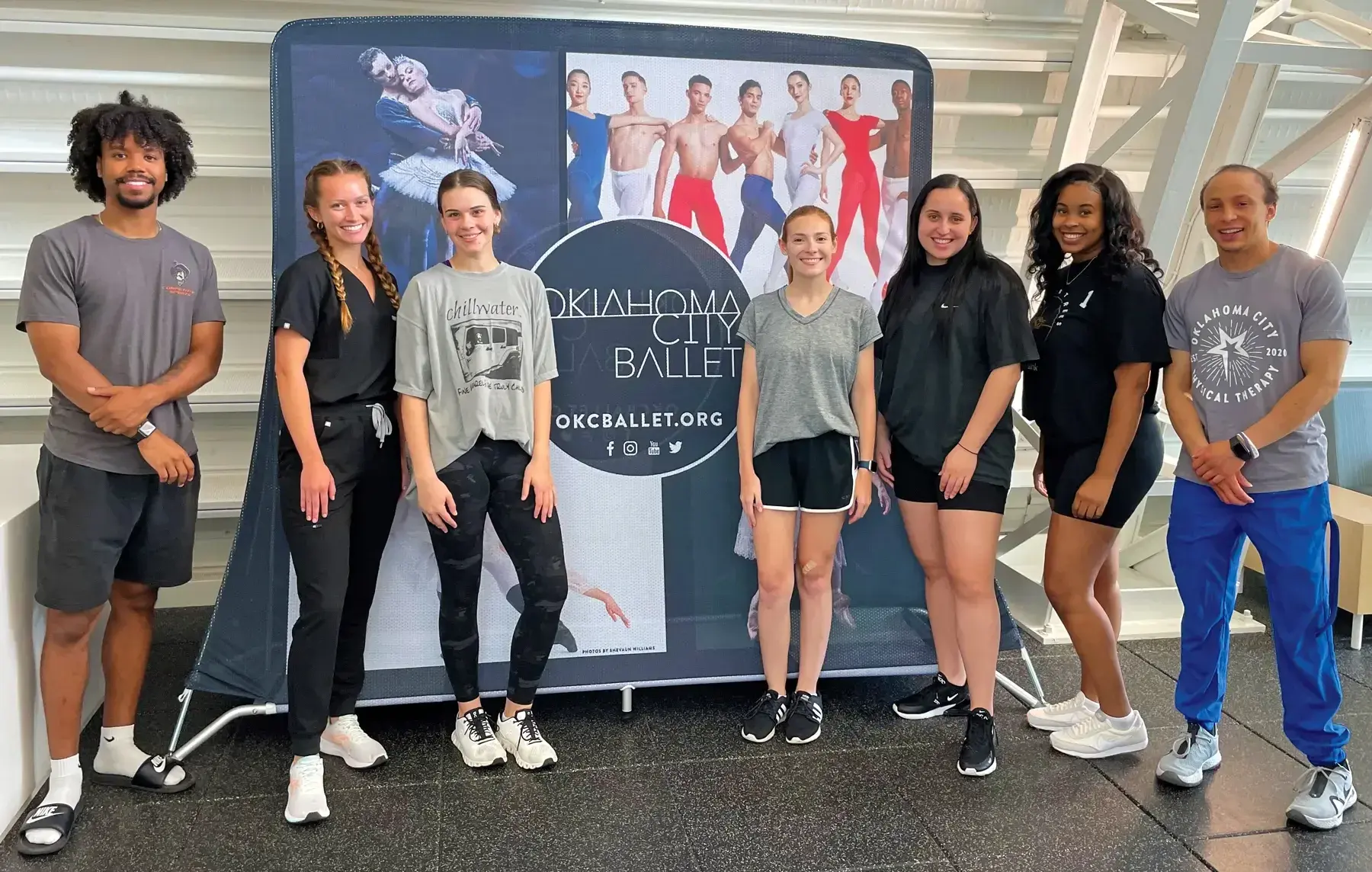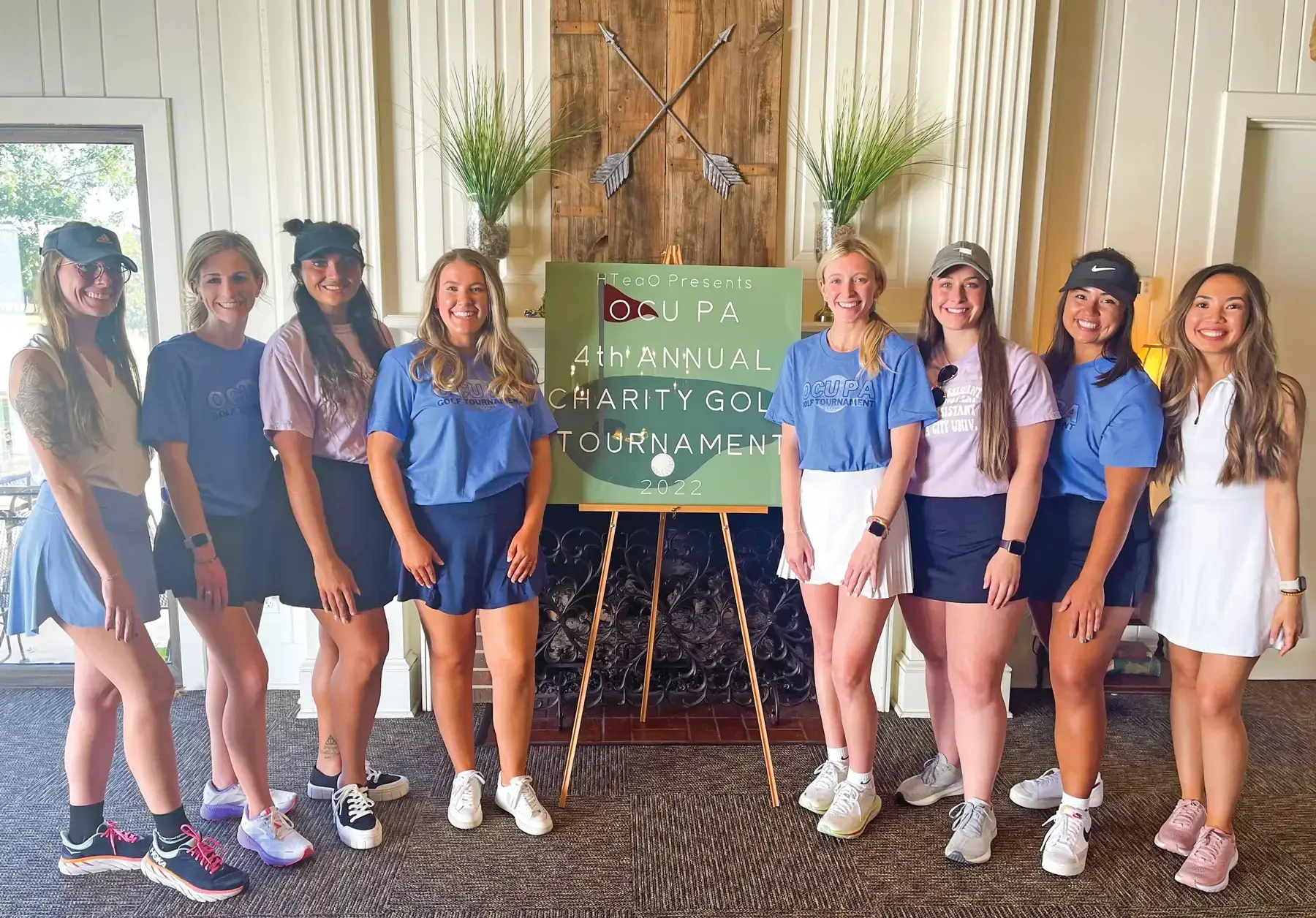FEATURE STORY
Health professions students learn by helping
by Rod Jones

Programs within the College of Health Professions have woven service learning into the very fabric of their curricula. These partnerships have been established to make a meaningful impact in the community for years to come, while also providing a real-world learning experience for the students.
The College of Health Professions was established in 2021 to encompass the Kramer School of Nursing and the university’s Physician Assistant and Physical Therapy programs.
Here are some of the ways students have been improving public health while learning along the way.
Physician assistant students join the flock at Good Shepherd Clinic
Access to health care can be tough. Access to health care without insurance can seem nearly impossible. Thankfully, there are clinics out there like the Good Shepherd Clinic in Midtown “∞¿«…Á«¯, where Physician Assistant students have been volunteering their skills since the program began seven years ago.
The Good Shepherd Clinic, which recently merged with Crossings Medical Clinic, provides medical and dental care to medically underserved populations of Oklahoma.
The PA curriculum is split into two phases, didactic and clinical. OCU’s program is unique in that students gain real-world clinical experience through Good Shepherd during their didactic phase. That means they’re better prepared for when they begin their clinical rotations.
Physician assistant professor Becky Carlozzi has volunteered at the primary care clinic since 2014. In fact, OCU’s involvement helped lead to her accepting a faculty position here.
“There are a lot of barriers to health care for the uninsured, a problem made worse when preventive health care is not available,” Carlozzi said. “Good Shepherd helps to end delays in getting treatment. Sometimes a patient will come seeking treatment for one issue, but we’ll discover another problem while they’re there and can hopefully catch it early on.”
Students in each cohort take turns going to the clinic on Wednesday mornings for a shift. They start off in pairs, then as they progress in experience they transition to solo appointments, all while under faculty supervision. Each student will take a clinic experience five to six times in a calendar year, visiting one or two patients each trip. They are usually assigned to a patient on the Monday before their Wednesday appointments. Overall, PA program students are at the clinic about 20 times a year.
“The advanced students help train mentees in the cohort coming behind them,” said Carlozzi, noting that the student-helping-student scenario becomes yet another beneficial learning experience for both parties. Around the start date for incoming cohorts, a list of mentees goes to the mentors to start the pairing-up process.
Second-year PA student Kaegan Cullison had made a handful of visits as of February. Conditions she often sees are diabetes, hypertension and high cholesterol, among others.
“It feels great to see how we’re making a difference,” Cullison said. “The population we’re working with are often dealing with conditions that are difficult to control.”
The clinic visits also give students a chance to work with peripheral services like pharmacists, X-ray technicians and language translators.
Blanca Garrett is the charge nurse at the clinic. Garrett has experienced the clinic from three different perspectives — first as a patient, then volunteer and now as a staff member. She says working with the OCU students has “been a blessing,” and she enjoys helping them learn to interact with patients.
“We cannot teach the people skills, so this is a great place to learn that on their own,” Garrett said.
She started volunteering at the clinic in 2013, using her bilingual abilities to help bridge the communications gap between patient and caregiver. It’s a skill that becomes better with practice, as Garrett and Carlozzi both pointed out.
“There’s a lot of room for miscommunication, so it’s important for students to learn how to work through that while under experienced supervision. Not only with the patients themselves, but also with other professionals,” Carlozzi said.
DPT students take service-learning throughout the lifespan
Community service projects are baked into the curriculum for the Doctor of Physical Therapy degree at OCU. All students participate in projects reflecting three age groups — pediatrics, adults and geriatrics. The service-learning courses occur in each student’s first, third and fifth semesters. Before they enter their full-time clinical experiences, they complete service-learning projects with each age group.
“Our service-learning components are designed to promote health throughout the entire lifespan,” said Maria Jones, director of the DPT program. “Students get a chance to see the unique needs of populations of various ages. They’re trained as generalists – to ensure they can work with a person of any age who comes through the door.”
Cohorts are divided equally for their community service-learning projects. Students document their reflections through written assignments as they complete the service-learning project.

Pediatrics
The DPT program collaborates with two organizations to complete pediatric community service projects. One is Make Promises Happen, a weekend youth camp for children with disabilities at the Central Oklahoma Camp and Conference Center near Guthrie. The other is Chance to Dance, a community program for children with various physical and developmental abilities held at the “∞¿«…Á«¯ Ballet studios in north “∞¿«…Á«¯.
For Make Promises Happen, DPT students volunteer at weekend camps in the spring and fall. The students serve as counselors and arrive at camp on Fridays to receive some background information of the child they’ll be supporting , including the child’s medications, behavioral tendencies and medical diagnoses.
“On Saturday morning, our buddies arrive,” said DPT student Allison Shannon. “We say goodbye to the parents and get our buddies situated in their sleeping quarters. After that, it’s a full schedule until they leave on Sunday. There’s a lot of freedom for the kids to do what they want to do.”
Activities abound, and the campers can participate in as many (or as few) of them as they can fit into their day. There’s waterfront fun like fishing and paddle boats, an archery range and an ax throwing range. A custom-made ropes course has a specially designed incline on one side that allows those with mobility issues to navigate the obstacles.
All activities are intentionally designed to allow any camper — regardless of physical ability — to participate.
“We don’t say ‘no.’ We find a way to make it work for the individual,” said Cody Lawson, director of marketing for the camp and the Make Promises Happen program, where he has been on staff for four years and had volunteered for 15 years before that.
Each of the 30+ campers has an assigned, dedicated counselor. Besides having a reliable multitude of volunteer counselors from the OCU DPT program, Lawson says their physical therapy background provides an additional and important bonus.
“With the population we work with, it’s great to have volunteers who have that kind of knowledge. It gives our campers an educational experience that also helps prepare them for living on their own later in life,” he said.
Shannon, who first attended a camp session in 2021 and returned of her own volition in 2022, said her experience was likewise beneficial.
“Before the camp, I didn’t have as deep an understanding about some disorders. Having a real-life experience helped me solidify and understand more deeply what we were learning in class,” she said. “I also had so much fun I decided to go again.”
Amanda Porter, director of clinical education and the faculty coordinator for pediatric service-learning projects, said the experience helps students learn how to work with other health care professionals.
“Our students get the chance to work alongside other counselors, the camp nurse and camp directors who have backgrounds in special education and speech pathology. The activities at camp become educational opportunities that can’t be covered the same way in a classroom,” Porter said.
Chance to Dance is designed to be inclusive for children ages 7 and up of varying abilities. The goal is to provide an opportunity for community interaction, artistic expression and learning for all children. DPT students attend six weeks of classes and assist the children to participate in dance exercises and routines.
Teachers and assistants make prep work and routines fun for the children. Even the stretching exercises are turned into a little game.
“Sometimes the kids just want a buddy,” said Chloe Lamarque, a first-year DPT student. On her first visit, Lamarque expected more of a free-for-all, loosely scheduled workshop session. However, “It had an organized, structured feel while still being fun. It was interesting how they incorporated motor skills, lots of running and jumping, all set to music.”
Lamarque entered the DPT program in hopes of working in pediatrics after graduation, so she was glad to start her coursework with Chance to Dance.
“It was a great opportunity, something I might continue doing even after I graduate,” she said.
Adults
Adult DPT service learning is largely done on campus. Cohorts have worked with the OCU Esports team, employees, and students from the Department of Exercise and Sports Science.
Currently, the students assist with the ongoing collaboration between the DPT program and the Ann Lacy School of American Dance and Entertainment. Dr. Kimberly Veirs, the faculty coordinator, says due to the physical demands of dance it is important to catch injuries early so they don’t become chronic problems.
“Dancers are often hesitant to report pain and injuries because they fear they will be told to stop dancing,” she said. “It is vital to the dancer's longevity to get help from health care providers specializing in dance medicine when they start to feel discomfort greater than their everyday soreness, so it does not result in injury requiring them to modify or stop dancing. We seek to shift the dancers’ mindset that dancing with pain is an expected part of the profession and aim to diminish the stigma of seeking help from health care providers who understand the unique culture of dance.”
In September 2022, incoming dance majors can participate in dance-specific pre-participation screens. Various measurements were taken to provide baseline information, such as strength, flexibility and dance technique, to uncover potential risk factors for injury. Screenings are held in the DPT lab in the Dawson-Loeffler building, and dancers work with DPT students and program faculty to learn exercises that may help prevent future or further injury. They can also schedule sessions for ongoing help throughout their time as a dance major.
Geriatrics
For the geriatrics section, DPT students visit Healthy Living Center – OKC, a fitness and activity facility geared toward promoting wellness in adults 55 and over.
OCU students attend classes once a week with center members to work on intergenerational socialization. The students are tasked with creating a wellness project for the members and to get to know their specific wellness needs through candid discussions.
Working in groups, they come up with a project to improve wellness in at least one dimension such as physical, mental or social aspects. Previous projects have included building an underwater walker out of PVC material, allowing members with limited mobility to safely enter a swimming pool via a ramp; an information session on the benefits of Tai Chi; a balance and falls risk safety screening; an exercise ball and drum class for aerobic and social benefits; and a short seminar on the benefits of stretching and nutrition for aging adults. The students present their projects and gather feedback to improve their presentations.
“This experience gives our students a chance to practice their community wellness projects before they graduate, in the hope they will continue giving back this way once they are licensed and practicing clinicians,” said Dr. Christina Wright, the faculty coordinator for the Healthy Living Center projects.
